|
The motor controller is the device which controls the flow of power from the batteries to the motor, allowing you to vary the speed and acceleration of the vehicle. Many years ago motor controllers consisted of contactors and/or resistor networks, but all modern motor controllers are based on transistors amplifiers controlled by microprocessors.
Topology of a Modern Motor Speed Controller
The diagram below shows a typical topology for a motor speedcontroller. They
use a microprocessor to drive a preamplifier and then power stage amplifier
which controls the flow of power from the battery to the motor, with various
feedback sensors to monitor the system's operation. Red arrows indicate pulse
width modulated outputs, green indicates feedback sensors.
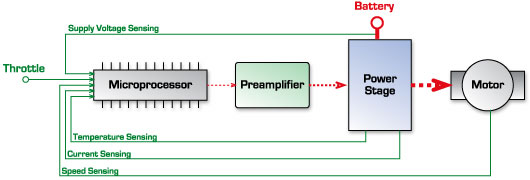
What is Pulse Width Modulation?
|
All modern motor controllers use some form of Pulse Width Modulation
(PWM) to vary the amount of power being delivered to the motor
from the power source (e.g batteries).
PWM is the process of switching the connection between the source
and load very rapidly to simulate a lower average voltage. The
frequency of switching is usually around 20 000 times per second
(20kHz) to keep it outside the human hearing range.
(Due to the inductive nature of the motor, most controllers effectively
behave somewhat like a buck converters – for more information,
check out wikipedia's
entry on buck converters.)
|
 |
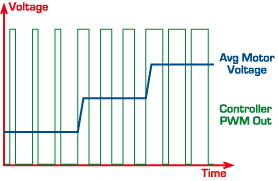 |
Microprocessor and Sensors
 |
The microprocessor's primary responsibility is generating
an appropriate PWM signal for the power electronics based on the
status of the various sensors. Some controllers will use dual
microprocessors for safety (so if either processors fault, the
system will shut down gracefully). As well as the throttle input,
most controllers should support the following sensors:
- Voltage: Too high a supply voltage can damage the motor
and/or power stage. Too low a supply voltage can mean the
batteries are over-discharged, which can cause them irreversible
damage.
- Current: Most controllers will include a variable current
limit to protect components.
- Temperature: To avoid damage to the power stage due
to thermal overload. Some controllers may also support thermal
sensors on the motor.
- Speed: Useful for detection of stall conditions or
overspeed, which can both damage the motor. Can also be used
for cruise control on some controllers.
|
Power Stage
The heart of the power stage is a bank of transistor amplifiers
– usually either MOSFETs or IGBTs.
- MOSFET stands for Metal Oxide Semiconductor Field Effect Transistor.
These are more common among lower voltage controllers since
low voltage MOSFETs tend to have very low on resistance (and
hence power loss). MOSFET controllers are very efficient at
low power levels, since power loss in a MOSFET is proportional
to the square of the current. Their resistance also increases
as they heat up, so when used in parallel they tend to automatically
balance the load.
- IGBT stands for Insulated Gate Bipolar Transistor, and it
somewhat like a hybrid between bipolar transistors and field
effect transistors. IGBTs have a constant voltage drop which
makes them more efficient than MOSFETs at high power levels,
though often less efficient for low power applications. One
disadvantage with IGBTs is that, like all bipolar transistors,
they are prone to thermal runaway and imbalances when used
in parallel. As such IGBT controllers require good cooling
systems (liquid cooling is common) and/or matched transistors
to avoid imbalance.
| 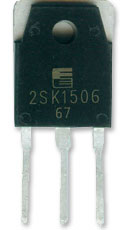 |
Major manufacturers
- Curtis Instruments make
a range of DC motor speed controllers with power ranging up to 144V 500A
(72kW). The Curtis 1231C is probably the most commonly used controller
in EVs around the world.
- Cafe Electric make controllers ranging from 156V 1000A (156kW) to
350V 2000A (700kW!), CafeElectric Zillas are a popular choice for many
high performance EVs using series DC motors.
- Siemens are the main supplier of
controllers (and motors) for AC induction drive systems. AC equipment is still kind of
pricey at present.
- ZEVA currently produces an ecomonical 144V 600A (86kW) series DC motor speed
controller for use in small road-going cars.
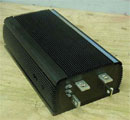
Curtis 1231C
|
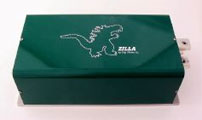
Cafe Electric Zilla2K
|
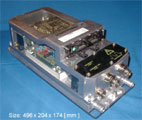
Siemens Simotion
|
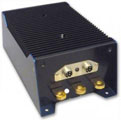
ZEVA MC600S
|
|








